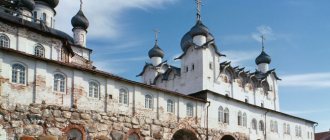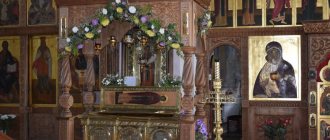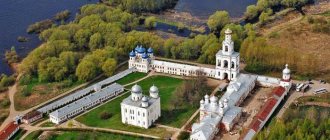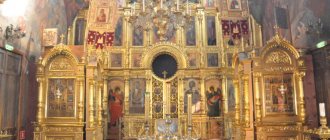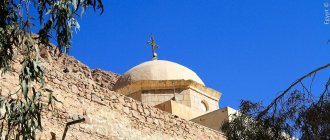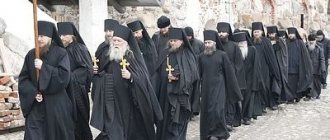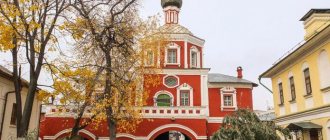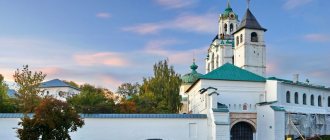Short story
According to one legend, Zosima had an extraordinary vision, the object of which was a church of indescribable beauty. Surrounded by heavenly radiance, she stood in the east.
Having seen a sign from above in a vision, in 1436 Zosima and his comrade built a temple made of wood with a refectory and a chapel - through its construction they honored the Transfiguration of the Lord. Some time later, in honor of the Dormition of the Most Holy Theotokos, the monks built a church, and both buildings became the main buildings of the Solovetsky Monastery.
Solovetsky Monastery from a bird's eye view
Jonah, Archbishop of Novgorod, issued a document to the monastery confirming its eternal ownership of the Solovetsky Islands. Subsequently, such a letter was issued to the monastery and all subsequent Moscow sovereigns. The image of the monastery standing in the middle of the White Sea was present on all ancient maps of Muscovy in the 16th century, and its appearance symbolized the unity of statehood and the Orthodox faith in Northern Rus'. Historians have noted that many cities of significant size were not on ancient maps, but the Solovetsky Monastery, as an outpost of Russia, was always present on them.
View of the Spaso-Preobrazhensky Solovetsky Monastery from the White Sea
Since the second half of the 16th century, construction work using stone has been carried out in the monastery under the leadership of Abbot Philip. From 1552 to 1557 With the participation of the best architects, the monks are working on the construction of the Church of the Assumption of the Mother of God with the Refectory and Cellar Chambers. Over the course of these same five years, the monks expanded the monastic pastures, laid roads, and built mills. Lakes, the number of which exceeds 70 names, are connected into a single system thanks to the laying of canals. A farm appears on the island of Muksalma. Finally, the main temple of the Solovetsky monastery, the Transfiguration of the Savior, was founded and erected, the consecration of which took place in 1566.
Korozhnaya Tower
At the end of the 16th century, the monastery on the Solovetsky Islands received the status of a fortress - it defended the northwestern borders of the Russian state.
In 1578, Ivan the Terrible himself transferred artillery to the monastery-fortress, and 6 years later, Tsar Fyodor Ivanovich issued a decree on the construction of stone walls around the monastery site. The work was carried out over 12 years, and as a result the monastery was surrounded by 11-meter walls made of 6-ton smooth boulders. For strength, lime mortar was laid between them with a gasket in the brick seams. The largest boulders are located below and act as a base. With the gradual reduction of the overlying stones, the wall becomes thinner. In the upper part of the walls, looking into the monastery courtyard, there are covered wooden galleries - from them, through the loopholes, shelling of the advancing enemy was carried out.
Holy Gate under the Annunciation Church
The installation site for artillery was several tiers of tower floors. In total, the monastery has 8 tower structures. Pryadilnaya, Storozhevaya and Uspenskaya are visible from Blagopoluchiya Bay. Kvasovarnaya, White, Povarennaya, Northern and Southern towers stand in relation to the courtyard from the side of the Holy Lake. All cone-shaped towers end with high tents with patrol platforms equipped in them. Similar to the construction of walls, the towers at the base were laid out from massive boulders, and at the top, under the tents themselves, from bricks. The difference in the thickness of the lower and upper parts of the walls reaches 4.5 m (at the bottom these values vary within 5 - 6 m, and at the top they are the same and amount to only 1.5 m). Despite this, all the walls and towers were so strong that no enemy force could damage them and penetrate the monastery lands.
Korozhnaya Tower with part of the monastery wall
Real military glory came to the monastery during the Crimean War, when it had to withstand a single, but very powerful bombardment by English 60-gun frigates (the event dates back to 1854).
The cannonade continued for 9 hours, and during this time the warships fired about two thousand bombs and cannonballs from their cannons. But they had to sail away without results, because with their actions they managed to achieve only minor damage to individual buildings.
Cook Tower
Shrines
The monastery on Solovki preserves relics revered by the Orthodox world - icons, crosses, relics of saints. Here the reverend fathers, whose lives are connected with the monastery, found their final refuge.
Table 1. Information about saints
| The Saints | Repose date | Year of canonization | Time of transfer to the monastery |
| St. Savvaty | 1435 | 1547 | 1566 |
| St. Zosima | 1478 | 1547 | 1566 |
| St. Hermann | 1479 | 1692 | 1484 |
| St. Philip | 1569 | 1636 | 1591 |
| St. Markell | 1663 | 2004 | 2003 |
| Smch. Peter | 1929 | 2000 | 1999 |
Figure 2. Crayfish with the relics of St. Zosima, Savvaty and Herman
The Spaso-Preobrazhensky Monastery preserves the holy icons:
- a copy of the image of the Mother of God Hodegetria, with which St. Savvaty came to the island;
- The list of the icon of the Mother of God of Tikhvin is called “Zapechnaya” or “Bread”, since St. appeared. Philip during obedience in the bakery;
- the miraculous Korsun image of the Blessed Virgin Mary “Sosnovsky” was found on a pine tree in 1627;
- 17th century icon with the image of St. Savvaty and Zosima.
The shrines include a prayer cross made of white stone, which belonged to St. Savvatiya. This is indicated by the inscription on the lower blade of the relic. The item was acquired by Abbot Philip in 1556. After the monastery was closed by the Bolsheviks, the cross was in the museum and returned to Solovki in 1993.
Architectural features of the Solovetsky Monastery
The territory of the monastery has a pentagonal shape. The whole of it is surrounded by massive walls with seven gates. The total length of the walls is 1084 m.
Today, temples and some buildings have been preserved in the courtyard of the monastery, connected to each other by covered passages and surrounded by residential and utility premises.
Cathedral of the Transfiguration
In addition to the three-domed Assumption and five-domed Transfiguration Cathedral, on the territory of the Solovetsky Monastery there are three churches: Trinity, Annunciation, Nikolaevskaya. There are separate stone chambers, a bell tower and a water mill. The appearance of both cathedrals seems stern, almost serf-like.
Thus, the corner chapels of the Transfiguration Cathedral resemble fortress towers, and the thickness of its walls reaches 5 m. In general, the architectural design of the cathedral is quite complex. The corner chapters rise above the upper aisles, which, in turn, are connected by passages and stand on vaults.
Assumption Tower
In 1923, disaster struck the monastery courtyard - a severe fire led to the melting of some of the bells and the spire.
But restoration work was not carried out on the bell tower building, and a metal star took the place of the fallen cross. In 1985, it was dismantled and transferred for storage to the Solovetsky Museum. In 2003, the reconstruction of the bell tower spire did take place, and upon completion, a majestic titanium cross appeared in its place.
Gallery
The Alexander and Petrovskaya chapels, standing in front of the monastery courtyard, did not lose their original appearance. Their construction in the middle of the 19th century immortalized the visit of the monastery - an ancient fortress by Tsars Alexander II and Peter I. At the entrance to the monastery there is a sundial - a decorative detail uncharacteristic of Orthodoxy.
From left to right: Church of St. Nicholas the Wonderworker with a bell tower, Spaso-Preobrazhensky Cathedral
The iconostasis of the Transfiguration Cathedral, made of two dozen boards arranged in 3 rows, was taken away by the Old Believers after the “Solovetsky sitting”. At the beginning of the 21st century, a citizen of Lithuania announced to the whole world that he had boards from the Transfiguration iconostasis, and put them up for sale, setting a price of 1 million 700 thousand euros for all seven boards. At the same time, the icons were on display in Groningen. But after the Ministry of Culture considered the issue of purchasing the iconostasis, it was announced that the state was not interested in such an expensive acquisition. This decision was made after the conclusion of restorers who doubted the authenticity of the iconostasis.
Nikolskaya Tower and Nikolsky Gate
Patronal holidays
Patronal feasts are celebrated in honor of a memorable event in the history of the Church. Another reason for celebration may be a saint whose life is connected with a temple or monastery. There are five such dates in the Spaso-Preobrazhensky Monastery.
Patronal holidays of the Solovetsky Monastery:
- Transfiguration of the Lord - August 19.
- Repose of St. Zosima - April 30.
- Transfer of the relics of St. Zosima - August 21.
- Transfer of the relics of St. Savvaty, Zosima and German - August 21.
- Commemoration of the Solovetsky saints - August 22.
Worship crosses - monuments of the Solovetsky Monastery
The cross-monument, issued in honor of the Pechersk wonderworkers Theodosius and Anthony, can be seen 6 miles from the monastery in the direction of St. Isaac's monastery. The monk Diodorus, a resident of the Holy Ascension Skete, worked on its creation. Previously, in this place there was a chapel in honor of the mentioned miracle workers, and an ancient carved cross made in the 17th century was preserved in it. During the camp, the wooden chapel with the valuable cross was lost.
Inside the Spinning Tower
In total, the servants of the Solovetsky Monastery from the end of the 20th to the beginning of the 21st century installed up to 20 worship crosses.
According to Archimandrite Joseph, the abbot of the monastery, the crosses serve as unique monuments that pass on to generations the former greatness of the ancient monastery, since lost chapels, temples and places memorable for the life of the monastery have traditionally become the places where they were installed.
Inside the Gallery
Hermitages, deserts, farmsteads
In addition to the monastery itself, there are (existed) several hermitages, hermitages, and farmsteads assigned to the Solovetsky monastery, located both on the Solovetsky Islands themselves and outside them.
- Big Solovetsky Island: Ascension Monastery
- Isaac's Hermitage
- Makarievskaya Hermitage
- Savvatievsky monastery
- Old Pine Wilderness
- Filippovskaya Hermitage
- Golgotha-Crucifixion Skete
- Sergievsky monastery
- St. Andrew's Skete
- Iron Hermitage is an iron-making weapons factory owned by a monastery, operating in the 16th-18th centuries in Korelsky district, founded on the orders of the abbot of the Solovetsky Monastery Philip.
Solovetsky Monastery as a prison
For 4 centuries, the monastery on the Solovetsky Islands was used as a political and church prison. The chambers, shaped like a truncated cone, were located in the walls and towers of the monastery. The length of the chambers was 3 m, the width and height were 2 m each, and at the narrow end they occupied only 1 m. But in some towers the chambers were even tighter. Thus, in the Golovlenkovskaya Tower they were located on the upper floors and occupied 1.4 m in length and 1 m in height and width. The small window in the cells was intended for serving food, not for lighting. While in custody, prisoners were not supposed to lie down - they were allowed to sleep in a half-bent position.
View of the Church of Philip Metropolitan
In another tower of the Solovetsky Monastery, named Korozhnya, there were prison cells on each floor. The dark and cramped closets had no doors. In order for the prisoner to get inside, he had to crawl through the small holes provided in the cells as an entrance. The number of prison cells in the monastery was constantly growing. In 1798, one of the existing buildings was converted into a prison, and in 1842, a three-story building and separate barracks for guards were specially erected to house prisoners. In the semi-dungeon, on the lowest floor of this new prison, there were small closets. They had neither shops nor windows, but placed especially dangerous criminals in such harsh conditions.
Attraction rating:
Rating 3.93 [14 vote(s)]
| ← RUSSIA | ARHANGELSK REGION | EUROPE → |
Information for pilgrims and travelers about Solovki
When planning a voyage to the monastery, the pilgrim needs to figure out how to get to the final point of the route and choose a place of future residence. Information about the peculiarities of the trip will be useful.
Road to Solovki
There are two ways to get to the island - by air or by land and sea transport. In the first case, travel time is reduced, the second option is more economical.
From Moscow or St. Petersburg they fly by plane to Arkhangelsk. From here, from Vaskovo airport to Solovki, there is one flight every day, except Thursdays, at 13:20. Flight time on the L-410 is 50 minutes, cost is 7,500 rubles. The return flight departs at 14:40.
When traveling by land, you need to take the train that goes to Murmansk, but issue a ticket to Kem station. In the city, tourists go to the pier, where a boat is chartered to ferry visitors to the island. The price of a train ticket from Moscow is from 3 to 11 thousand rubles. The cost of sea voyage is from 1,800 rubles, travel time is 2 hours.
Where to stay on Solovki
You can find accommodation in a hotel, private sector, or put up a tent at a campsite. The addresses of the apartments can be found in the pilgrimage service of the monastery. The owner of the property talks about the price. Tent camp, where a daily stay costs 300 rubles. per person, located 10 minutes walk from the monastery.
Table 3. List of hotels on the island
| Name | Walking distance from the monastery, min. | Room capacity, persons | Minimum price per day, rub. |
| "Solovki Company" | 25 | 1; 2; luxury | 1000 |
| "Shelter" | 3 | 1; 2; 3 | 3000 |
| "Solo-Nord" | 3 | 1; 2; 3 | 2000 |
| "Solovetskaya Sloboda" | 7 | 2; 3 | 4500 |
| "Solovki-hotel" | 15 | 1; 2; junior suite; luxury | 2500 |
| Museum dormitory | 1 | Multi-seat | 800 |
Some local rules
There are no ATMs on the island, so you should stock up on cash. Money will be needed to pay for excursions and purchases. Chargers and flash drives for gadgets are required. When traveling, a first aid kit may come in handy.
Important! While on Solovki, you should not forget about possible rapid weather changes. In a few minutes, the bright sun can be covered by rain clouds, and gusty winds can blow. Given the local climate, it is recommended to take waterproof clothing and a pair of sports shoes.
Figure 4. Procession
Service Schedule
On weekdays, services begin in the morning at 6 a.m. and in the evening at 5 p.m. A prayer service with the reading of the akathist of St. Petersburg is added to the Wednesday schedule. Savvaty, Zosima and German. On Sundays, on the days of the great and twelve feasts, the service begins at 8:00. At the end, if the weather does not interfere, a religious procession is held.
The riches of the islands in the White Sea attracted many people. But the money-grubbers could not withstand the trials that befell them. Only strong-willed Orthodox ascetics with deep faith were able to gain a foothold on the Solovetsky land.

